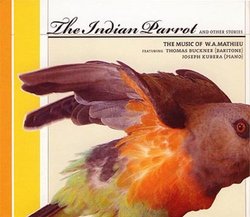| All Artists: W. A. Mathieu Title: The Indian Parrot Members Wishing: 1 Total Copies: 0 Label: Mutable Music Original Release Date: 1/1/2007 Re-Release Date: 11/1/2006 Genres: Jazz, Pop, Classical Styles: Vocal Jazz, Vocal Pop, Chamber Music Number of Discs: 1 SwapaCD Credits: 1 UPC: 801021752424 |
Search - W. A. Mathieu :: The Indian Parrot
 | W. A. Mathieu The Indian Parrot Genres: Jazz, Pop, Classical
Mutable Music is pleased to announce this latest release by William Allaudin Mathieu, pianist, composer, teacher, recording artist, and author. A Parrot, Three Fish, and a Donkey is a modern piece with a medieval text, and... more » |
Larger Image |
CD Details
Synopsis
Product Description
Mutable Music is pleased to announce this latest release by William Allaudin Mathieu, pianist, composer, teacher, recording artist, and author. A Parrot, Three Fish, and a Donkey is a modern piece with a medieval text, and medieval sensibilities have worked their way into the musical fabric: the small percussion instruments, the instrumental range lying (for the most part) within the range of the human voice, and, most of all, the harmony, which is a kind of modulating modality. Inspired by the universality of Rumi s poems, Mathieu felt especially free in this piece to borrow from many centuries of Eastern and Western harmonic practice. Daniel Abdal-Hayy Moore's The Blind Beekeeper is a wonderful poem. It asks the soloist-narrator to simultaneously play so many roles. His first line is spoken: "I'd like to make a movie called The Blind Beekeeper..." and from then on he is above all a movie pitch-man -- and we are producer-angels deciding if we are going to invest in this guy's nutty movie. But he is also telling a dramatic and compelling story, empathizing with a diverse array of characters. And, since (at least in live performance) he will lead an audience of angels in transformative acts of bee-participation, he becomes our conductor as well. Finally, of course, he's a concert baritone giving a performance of a contemporary art song, a circumstance true even for the most post modern of us. The piece is divided along the lines of a standard three-reeler: In the expository first reel (parts 1 and 2 of the text), we see Henry's history and very special talent; then we are inside the hive, and meet the bee protagonists. The second reel (part 3) is all action and adventure: the lover-bees get into serious trouble. The third reel (parts 4 and 5) is the triumphal rescue and final celebration. By the end we have seen a bee-movie about very small events as well as very large ones. Like a good children's story, it is at the same time a slightly silly tale and a noble miracl

 Track Listings (13) - Disc #1
Track Listings (13) - Disc #1